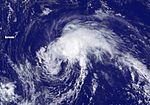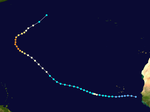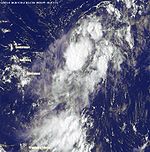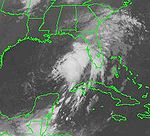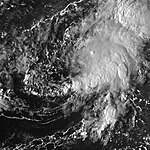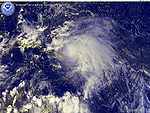Atlantic hurricane season 1999
 All the storms of the season | |
| Formation of the first storm |
June 11th |
|---|---|
| Dissolution of the last storm |
November 23 |
| Strongest storm | Floyd - 921 hPa ( mbar ), 135 kn (250 km / h ) |
| Storms | 12 |
| Hurricanes | 8th |
| Severe hurricanes ( Cat. 3+ ) | 5 |
| Total number of victims | 465 |
| Total damage | $ 5.9 billion (1999) |
|
Atlantic hurricane seasons 1997 , 1998 , 1999 , 2000 , 2001 | |
The 1999 Atlantic hurricane season officially began on June 1st and lasted until November 30th, 1999. This period traditionally delimits the period of the year in which most tropical cyclones form in the Atlantic Ocean .
The 1999 season set a record with five storms becoming category four hurricanes. That record was broken six years later by the 2005 Atlantic hurricane season . Hurricane Floyd , which accounts for 57 deaths and billions in damage on its east coast train , has been the most killing hurricane in the United States since Hurricane Agnes in 1972 . Wrong Way Lenny killed 17 people on its way east across the Caribbean and was the first hurricane known to have such a course over a long period of time. Lenny reached top wind speeds of 250 km / h, making it the strongest Atlantic hurricane in November just 13 days before the official end of the season.
Storms
Tropical storm Arlene
| Tropical storm | |||
|---|---|---|---|
|
|||
| Duration | June 11th - June 18th | ||
| intensity | 50 kn (95 km / h ) (1 minute) , 1006 hPa | ||
A low pressure area at medium to high altitudes developed in early June at the tail end of a diffuse front system in the mid Atlantic. As the system migrated northward, convection and circulation developed at a low level. It was classified as Tropical Depression One on June 11 and, under favorable conditions, intensified several hundred kilometers southeast of Bermuda to form Tropical Storm Arlene on June 12 . The storm moved roughly to the northwest and reached wind speeds of 95 km / h when it was 185 km from the island on June 17th. He turns away from the island, heading north, where high wind shears caused Arlene's dissolution on June 18th. No damage was reported.
Tropical Depression Two
| Tropical depression | |||
|---|---|---|---|
|
|||
| Duration | July 2nd - July 3rd | ||
| intensity | 30 kn (55 km / h ) (1 minute) , 1004 hPa | ||
Tropical Depression Two formed on July 2 in the western Gulf of Mexico from a tropical wave. After the landfall on July 3, about 120 km south-southeast of Tuxpan , the system quickly disintegrated. It brought heavy rainfall in the area, the maximum of which was recorded at 517 mm near Tanzabaca / Tamasopo in Mexico . The system has not caused any known death or property damage.
Hurricane Bret
| Category 4 hurricane | |||
|---|---|---|---|
|
|||
| Duration | August 18 - August 25 | ||
| intensity | 125 kn (230 km / h ) (1 minute) , 944 hPa | ||
The tropical depression that formed in the Bahía de Campeche on August 18 reached tropical storm status on the evening of the following day. Bret migrated north and became a category four hurricane by August 22, with winds of 220 km / h. As the hurricane neared Texas , Bret turned northwest and hit the coast off Padre Island on August 23 as a Category 3 hurricane . Bret was the first major hurricane since Hurricane Alicia hit Texas in 1983. The storm continued inland and broke up over northern Mexico on August 25th. The property damage is estimated at 60 million US dollars , which is rather little for a hurricane of this intensity. Bret encountered sparsely populated Kenedy County , missing Brownsville south of it and Corpus Christi north. The hurricane quickly resolved after the NHC's final warning hit the city of Laredo .
Hurricane Cindy
| Category 4 hurricane | |||
|---|---|---|---|
|
|||
| Duration | August 19 - August 31 | ||
| intensity | 120 kn (220 km / h ) (1 minute) , 942 hPa | ||
A tropical wave broke away from the coast of Africa on August 18 and quickly developed into Tropical Depression Four on August 19, about 480 km east-southeast of the Cape Verde Islands . Sustained westerly wind shears initially prevented further development, but a decrease in shear allowed the trough to intensify into a tropical storm on August 20. Cindy quickly reached hurricane status but weakened to a low again due to an increase in wind shear. When the adverse conditions disappeared and Cindy quickly turned into a Category 4 hurricane with winds of 225 km / h, the system was about 690 km east-southeast of Bermuda . The shear increased as Cindy turned northeast, and on August 31, the storm broke up as it combined with an extra-tropical storm about 1,600 miles west of the Azores .
Hurricane Dennis
| Category 2 hurricane | |||
|---|---|---|---|
|
|||
| Duration | August 24th - September 9th | ||
| intensity | 90 kn (165 km / h ) (1 minute) , 962 hPa | ||
Dennis was a category two hurricane that was erratic in both path and intensity. Although the storm did not land as a hurricane, it was responsible for hurricane-strength winds along the North Carolina coast, causing widespread beach erosion . The hurricane caused 157 million dollars in property damage and killed four people. Its heavy rains prepared the field for the devastating flash floods caused by Hurricane Floyd about two weeks later.
Tropical storm Emily
| Tropical storm | |||
|---|---|---|---|
|
|||
| Duration | August 24th - August 28th | ||
| intensity | 45 kn (85 km / h ) (1 minute) , 1004 hPa | ||
Emily formed on August 24th from the same area of tropical waves that produced Hurricane Cindy and Hurricane Dennis. The storm moved roughly north until it was absorbed by Hurricane Cindy on August 28. Emily did not directly affect the mainland and no harm was associated with Emily.
Tropical Depression Seven
| Tropical depression | |||
|---|---|---|---|
|
|||
| Duration | September 5th - September 7th | ||
| intensity | 30 kn (55 km / h ) (1 minute) , 1006 hPa | ||
Tropical Depression Seven arose on September 5th from a tropical wave in the western Gulf of Mexico. It organized itself better as it moved north-northwest and hit the city of La Pesca , Tamaulipas on September 6 , before it could intensify further. The tropical thunderstorm caused severe. It is not known to what extent this resulted in death or property damage. In Texas this caused the remnants of the low rains, the maximum of 85 mm was observed in Harlingen .
Hurricane Floyd
| Category 4 hurricane | |||
|---|---|---|---|
|
|||
| Duration | September 7th - September 17th | ||
| intensity | 135 kn (250 km / h ) (1 minute) , 921 hPa | ||
Hurricane Floyd was a powerful and extensive Cape Verde-type hurricane that got its name on September 8, 750 nautical miles east of the Antilles . Floyd slowly strengthened and headed west-northwest, but remained well north of the Lesser Antilles . On September 11th, Floyd changed direction and moved almost due west and began to intensify. On September 13th, Floyd was a strong Category 4 hurricane with winds of 250 km / h and was close to reaching Category Five.
At that moment, Hurricane Floyd was due east of the Bahamas . Floyd weakened slightly as he moved across the islands and met Eleuthera Island . Upon reaching Abaco Island on September 14, Floyd was a hurricane at the lower limit of category four. Floyd then turned north and pulled parallel to the Florida coast, where it hit the mainland again as a Category 2 hurricane near Cape Fear . Floyd flooded again near Norfolk , Virginia and moved as a tropical storm along the coast of the Delmarva Peninsula and New Jersey . Floyd reached the coast of Long Island for the last time and then moved inland to New England .
Floyd caused record rainfall levels along the east coast , with the cities of Wilmington and Philadelphia recording 382mm and 168mm, respectively. Parts of New England reported nearly 280mm of rainfall. The storm surge reached 2.7 to 3 m along the North Carolina coast. A total of 57 deaths are attributed to Floyd, 56 of them in the United States and one in Grand Bahama . Most of the deaths were caused by flash floods in North Carolina. Floyd was one of the most expensive hurricanes observed, causing damage of approximately $ 4.5 billion.
Hurricane Gert
| Category 4 hurricane | |||
|---|---|---|---|
|
|||
| Duration | September 11th - September 23rd | ||
| intensity | 130 kn (240 km / h ) (1 minute) , 930 hPa | ||
Gert emerged from an African tropical wave on September 12th, a few hundred kilometers west of Cape Verde . Its course arched across the Atlantic and the system became a category four hurricane on September 16. Gert threatened Bermuda as a weak Category 2 hurricane, but is turning to the north-northeast. On September 23rd, Gert became extra-tropical and connected to another low pressure system off the coast of Newfoundland .
Gert caused gusts of wind at hurricane strength several times in Bermuda, but property damage was limited to coastal erosion . The hurricane caused no direct deaths, although two people drowned in Maine when a strong wave washed them into the sea. This wave is attributed to Gert even though the hurricane was over a thousand nautical miles away at the time.
Tropical Storm Harvey
| Tropical storm | |||
|---|---|---|---|
|
|||
| Duration | September 19 - September 22 | ||
| intensity | 50 kn (95 km / h ) (1 minute) , 994 hPa | ||
Tropical Storm Harvey formed on September 20 in the eastern Gulf of Mexico , approximately 300 nautical miles west-southwest of Saint Petersburg , Florida . Harvey reached the mainland on September 21st near Everglades City with winds of 90 km / h and an air pressure of 999 hPa. After Harvey crossed Florida eastward, Harvey connected to an extra-tropical cyclone over the northern Bahamas on September 22.
Harvey did not cause any deaths. Peak gusts reached 110 km / h. Two tornadoes have been linked to Harvey. One of them brought down a house in Collier County . Harvey property damage amounts to $ 15 million.
Tropical Depression Elf
| Tropical depression | |||
|---|---|---|---|
|
|||
| Duration | October 4th - October 6th | ||
| intensity | 30 kn (55 km / h ) (1 minute) , 1002 hPa | ||
A tropical wave developed over the Bahía de Campeche to the Tropical Depression Elf on October 4th . Driven by weak currents, the system migrated south and then west, but remained weak due to a wide ridge on the surface over the Gulf of Mexico. The deep and the trough joined on October 6th, winds of the strength of a tropical storm only occurred over the coast. The deep, poorly developed circulation, along with previous rainfall, resulted in the worst flooding in four decades, killing at least 384 people in the region.
Tropical Depression Twelve
| Tropical depression | |||
|---|---|---|---|
|
|||
| Duration | October 6th - October 8th | ||
| intensity | 30 kn (55 km / h ) (1 minute) , 1007 hPa | ||
The tropical low pressure area Twelve developed on October 6th between the Lesser Antilles and Cape Verde from a tropical wave. It wandered wandering west-northwest without developing any further. The low circulation was mostly on the western side of the convection, which was caused by a channel near the ground in the north. The convection weakened and broke up on September 8th when the circulation became less well developed. The remnants of the low moved for a few days towards the west-northwest, but then completely dissolved north of the Lesser Antilles.
Hurricane Irene
| Category 2 hurricane | |||
|---|---|---|---|
|
|||
| Duration | October 12th - October 19th | ||
| intensity | 95 kn (175 km / h ) (1 minute) , 958 hPa | ||
Irene emerged on October 12th from a wide depression south of the Isle of Youth . The system migrated north across the Isle of Youth and western Cuba on October 14th . Irene hit hurricane strength over Florida Street. The next day Irene reached the mainland at Key West , Florida and then again north of it, near Cape Sable . Later on, near Jupiter , Irene came back across the water as a minimal hurricane. Irene was slowly regaining strength as the hurricane hit the coast from Florida to North Carolina. Under the influence of a channel from the west, Irene intensified rapidly and as long as the hurricane was over the warm waters of the Gulf Stream , it reached wind speeds of 175 km / h. However, the forward speed increased to the northeast and brought the hurricane over the cold waters of the North Atlantic. On October 19, Irene went extra-tropical near Newfoundland and was absorbed by an extra-tropical low shortly afterwards, with which it formed a gigantic storm depression that reached Europe in a weakened manner.
Total economic losses from Irene in Florida is about 900 million US dollars , but there were no direct deaths in the United States that Irene be attributed (though were recorded eight indirect deaths). The damage in Cuba is unknown. Irene also contributed to the flood problems in North Carolina as a result of Hurricane Floyd.
Hurricane Jose
| Category 2 hurricane | |||
|---|---|---|---|
|
|||
| Duration | October 17th - October 25th | ||
| intensity | 85 kn (155 km / h ) (1 minute) , 979 hPa | ||
Jose formed about 400 miles east of the Leeward Islands on October 8th . The storm quickly turned into a hurricane and more than 2000 residents of the islands in its way were evacuated. It moved northwest and the hurricane struck the islands of Antigua , Saint-Barthélemy and Saint Martin on October 20 and 21 . More than 300 mm of precipitation fell on St. Martin. Jose weakened to a tropical storm as it approached the US Virgin Islands . On approaching Puerto Rico , Jose turned north-northeast and stayed in an almost straight line into the North Atlantic until it lost its tropical characteristics on October 25th and then merged with an extra-tropical system.
Jose caused one death in Antigua and another in St. Martin. Major damage has been reported to St. Martin from floods and landslides, but the total amount of damage is unknown. The damage in the affected Damage US areas was minimal.
Tropical storm Katrina
| Tropical storm | |||
|---|---|---|---|
|
|||
| Duration | October 27th - November 1st | ||
| intensity | 35 kn (65 km / h ) (1 minute) , 999 hPa | ||
Katrina turned into a tropical depression on October 27th. The following day, observation planes found a well-developed circulation movement near Panama . The storm migrated northwest and became Tropical Storm Katrina in the early afternoon of October 29th. However, Katrina only barely achieved this status and just six hours later the system weakened again to a low pressure area.
At Puerto Cabezas in Nicaragua , the system reached the mainland as a tropical storm. The storm made life a little harder for the people there, as they had to cope with the effects of severe Hurricane Mitch , which hit the country almost exactly a year earlier. Katrina dissolved over the Yucatán Peninsula on November 1, where the system was absorbed by a cold front.
According to the NHC , Katrina claimed no human lives in Nicaragua and the damage was minor.
Hurricane Lenny
| Category 4 hurricane | |||
|---|---|---|---|
|
|||
| Duration | November 13th - November 23rd | ||
| intensity | 135 kn (250 km / h ) (1 minute) , 933 hPa | ||
Hurricane Lenny was a devastating end-of-season hurricane that got its name over the western Caribbean on November 13. Lenny always moved east and is the only known storm to have done so over a long period of time. Lenny was a Category 4 hurricane when it passed Puerto Rico and the US Virgin Islands on November 17th. Its pulling speed slowed and the storm weakened as it pulled over the Leeward Islands . On November 19, the storm reached the mainland near Antigua, but then continued its wandering course out to the open Atlantic and finally dissolved there on November 23.
Seventeen deaths are directly attributed to the hurricane, including two in Colombia . The storm caused considerable damage on the islands, but there are only estimates of property damage for the US territories, which are given at 330 million US dollars .
Accumulated Cyclone Energy (ACE)
| ACE (10 4 kt 2 ) - storm: | |||||||||||||
|---|---|---|---|---|---|---|---|---|---|---|---|---|---|
| 1 | 42.31 | Device | 7th | 10.42 | Irene | ||||||||
| 2 | 29.42 | Floyd | 8th | 10.15 | Jose | ||||||||
| 3 | 24.62 | Cindy | 9 | 3.42 | Arlene | ||||||||
| 4th | 20.18 | Dennis | 10 | 2.42 | Emily | ||||||||
| 5 | 19.87 | Lenny | 11 | 1.89 | Harvey | ||||||||
| 6th | 11.60 | Bret | 12 | 0.25 | Katrina | ||||||||
| Total: 177 (176.55) | |||||||||||||
Accumulated Cyclone Energy (ACE) is a measure of how active a hurricane season is. It is determined by determining the wind speeds every six hours, squaring them individually and then adding them as long as they reach the strength of a tropical storm.
The ACE of this hurricane season is 177 · 10 4 kt 2 (since the ACE is always given to three digits, it is rounded from 176.55 to 177).
Storm names
The names in the list below were used for named storms that formed in the northern Atlantic Ocean . It is identical to the list for the 1993 Atlantic hurricane season . The list was reused , with the exception of the deleted names, during the 2005 Atlantic hurricane season . It was the first and only time that a storm was named Lenny. Storm names that were not used in 1999 are shown in gray.
|
Deletion of hurricane names
The World Meteorological Organization deleted two names in the spring of 2000, Floyd and Lenny. These were replaced by Franklin and Lee in the 2005 Atlantic hurricane season .
See also
Individual evidence
- ^ Hydrometeorological Prediction Center . Tropical Depression # 2. Retrieved February 9, 2007.
- ^ Tropical Depression # 7 ( English ) Hydrometeorological Prediction Center. Retrieved November 28, 2008.
- ↑ David M. Roth Tropical Depression 11A Rainfall Page. Retrieved June 18, 2007.
- ↑ Storm low from ex-Hurricane "Irene" . seewetter-kiel.de.
